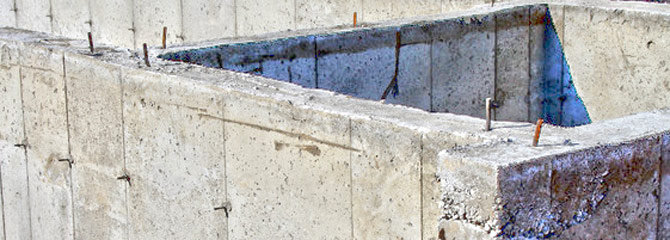There are several ways of repairing damaged foundations. All are equally effective and the method chosen by your contractor will depend on how bad the damage is to your home and the level of support the building needs. If all you need is basement waterproofing, by acting early you might be able to avoid the expense and inconvenience of future foundation repair in your Toronto home.
Method #1: Bell Bottom Piers
The bell-bottom pier was first discovered in the early 1900s by an engineer in Texas. Willard E Simpson became famous when he was commissioned to move a five-story bank building from one location to another. He devised a way to raise the building onto rollers, move it and slide it onto a new foundation – all while the bank remained open for business!
When a building developed foundation damage caused by soil movement, Simpson enlisted a local well driller to drill shafts through the foundation using a mule walking in a circle turning an auger. He then lowered a man down the shafts to widen them at the base, filled them with poured concrete and placed steel rebar in the wet concrete. Once set, the widened “bell” provided a solid footing for the home and stabilized the foundation.
Bell bottom piers have been used for more than 100 years and are a popular method of Toronto foundation repair.
Method #2: Steel Piers
Steel piers are mainly used in dry areas with sandy soil, or where hard earth between layers of clay provides resistance to inserting the pilings. The steel can be driven deeper into the ground, which is useful in dry soil where it takes more power to press it in than it does to lift the building. The main advantages of this method are:
- Shorter time frame because there’s no need to wait for the concrete to cure, and
- Easier/deeper insertion process into the ground.
There are also disadvantages, however, which include only being able to use this method on the perimeter of the building and the fact that the reliability varies depending on the firmness of the soil and the season of the year when the work is done.
Method #3: Press Pilings
This method of Toronto foundation repair uses precast concrete cylinders that are driven into a hole in the ground under the house. These are then “piled” up on top of one another until they form a column of support for the foundation. While this method is useful for short-term support, it isn’t reliable in the long term because the cylinders, which aren’t secured together in any way, can shift and become misaligned. Advantages include a shorter timeframe because the benefit is immediate, while disadvantages include:
- No steel reinforcement in the cylinders
- The depth to which the cylinders can be pushed depends on the weight of the house, so they might not reach stable soil.
- If any cylinders are broken or pushed out of alignment during the process the engineers are unable to see it.
- The process of driving the cylinders into the ground using the weight of the house can crack the slab of the home causing more damage to the foundations.
This remains a useful method of repairing foundations in certain circumstances, and by reinforcing the cylinders with rebar inserts engineers are able to avoid some of the problems associated with the process.
The best way to avoid needing Toronto foundation repair is to conduct regular inspections of your home. Get your basement waterproofing checked once a year and at the same time make sure your foundation is solid. That way you can avoid needing to spend vast sums of money on any of these methods.

